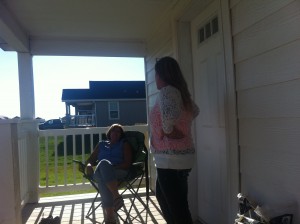
Rene and Shelly on front porch, Williston, ND.
The blue Pacifica chugged. Our gas mileage went from a paltry 18mpg towing a 6’x12′ Uhaul trailer over relatively flat terrain to a dismal 15mpg once we hit the hills outside Minot, North Dakota. I tried to keep the speedometer at a steady 60mph but some of the climbs reduced our forward progress to little more than a crawl. We made Williston, ND, where our son Dylan and his wife-to-be Shelly Helgesen make their home, after a two day journey from Duluth towing a trailer full of dressers, a king sized bed, mirrors, and a china hutch. We broke up the trip by staying over in Minot rather than taxing my patience. It was a wise decision.
As we came into Williston, Shelly gave us directions which, it turned out, were really misdirections. We were ten miles past Williston and headed towards the Montana state line when Rene’ and Shelly “recalculated”. By the time Dylan got off of work at Highland Crude where he’s a supervisor over fifteen other guys, Jack and I had the trailer unloaded and most of the furniture situated where Shelly wanted it. The bedroom set, two heavy cherrywood dressers, a mirror, and a king sized bed, box spring, and mattress were gifts from my dad to the kids. He recently sold the family home and downsized. Given that the furniture is in great condition, I called the kids to see if they wanted it. They said “yes” so Jack and I loaded the bedroom set into our open trailer on a sunny day and unloaded the furniture at our house, storing it in the garage until we made this trip. Jack has been a trooper, giving up four days of work at Dairy Queen and his summer vacation to help tote the bedroom set and the china hutch out to his brother’s place for no pay. The china hutch was one of our first purchases as a young couple so giving it to our son and his wife-to-be makes perfect sense. Plus, it looks great in their living room!
To an outsider, Williston appears consistent with everything written about the place. It sits along the Little Muddy River in a shallow bowl surrounded by naked hills, the victim or the benefactor (I’ll leave it for you to decide) of the oil boom in the Bakken formation. (See http://en.wikipedia.org/wiki/Bakken_formation for more information on the Bakken.) As you enter the valley just east of town, you pass hastily erected trailer parks and man camps, where thousands of invading workers extracting crude through hydraulic fracturing, or fracking, are being temporarily housed. US Highway 2, the main thoroughfare in and out of Williston, is clogged with industrial equipment, tractor trailers, a few cars, and an ocean of pick up trucks bearing license plates from nearly every state in the union. According to Dylan, the North Dakota employment folks he deals with say they’ve assisted job applicants from every state of the union save Hawai’i. One look at the traffic clogged, monochromatic, dust choked valley of the Little Muddy and you’d understand why anyone from Hawai’i has yet to seek their fortune in the Bakken. But we love our fossil fuels (myself included) and so, at least in the Bakken, Sarah Palin’s cry of “drill, baby, drill” has been heard.
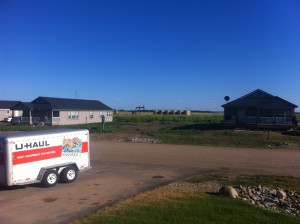
An oil well across the street from Dylan and Shelly’s house.
The photo at the left shows the UHaul after Jack and I unloaded it. The trailer is sitting in Dylan and Shelly’s driveway. If you look really close, you can see a brand new oil well behind the house across the street. That’s Williston. Every square inch of the landscape has some sort of tie to the new boom, whether it be new gravel roads cut across pastures or grain fields to access sites, or new oil wells plopped down in the same fields and pastures, or new pipeline routes or tank farms strategically located to move the oil and, to a lesser extent, the natural gas being sucked out of the prairie. Everything about the place feels temporary. The roads, the housing, the Walmart. All of the building and construction seems like a massive slight-of-hand that, once the oil dries up, or the EPA steps in, or the price per barrel for crude dips below what’s economically viable for fracking, will be left behind like a modern day version of the ghost towns of the historic West. Whether the end comes in two years or twenty, it will come. And what will be left behind will not be aesthetically pleasing, to say the least.
Saturday. We all climbed into the Pacifica and drove through town with Dylan and Shelly as backseat guides. Outside Williston, we checked out the Little Muddy and noted that, away from the noise, and bustle, and grime of the boom, the landscape here, just as Lewis and Clark noted on their journey west, has its own quiet dignity and beauty.
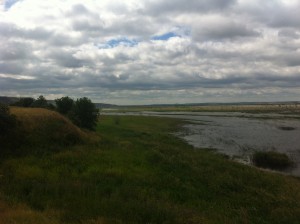
The valley of the Little Muddy.
We stopped at the interpretive center where the Yellowstone and Missouri Rivers meet. It’s a location featured prominently in Lewis and Clark’s journals. At the confluence, I observe that, despite the landscape’s unfamiliarity to those of us who grew up surrounded by trout streams, lakes, and tall pines, there is much to be admired in the serenity and sloping grace of the Great Plains.

The Confluence.
We drove a few more miles to the west and toured historic Fort Union, a place secured, not by our government for military purposes, but by various fur trading companies as a place to exchange goods with the First People. Our collective experience at Fort Union was fascinating, a remarkable step back in time. You’d expect crowds at such a well maintained attraction on a cool Saturday in July. Not so. Perhaps few of the workers who’ve infiltrated the Bakken are interested in history. Or perhaps, they’re just too tired from working 12 hour days to make the short trip out to see the fort on their days off. Whatever the reason, there were only a few dozen folks wandering the grounds, looking at the site and listening to the staff members (appropriately dressed in period costumes) provide insight into what life was like in the early 1800s.
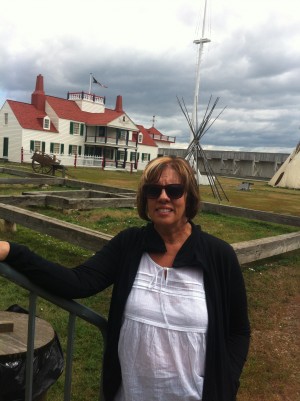
Rene’ at Fort Union.
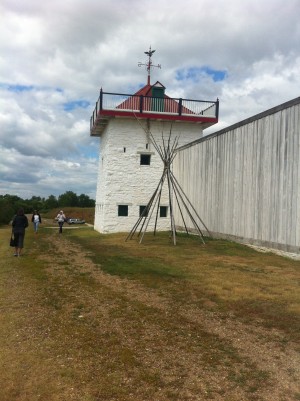
Fort Union, ND.
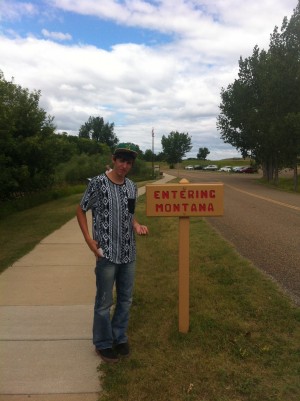
Jack at the border. Ft. Union, ND.
Sunday. We tumbled back into the Pacifica for another road trip to the north unit of Theodore Roosevelt National Park. Every year, on our annual ski sojourn to Bridger Bowl in Bozeman, MT, we pass by the south unit of the park and I lust after memory.
I remember going to the park with my mom and dad when I was 7, on our trip out to Seattle.
Until this trip to the Bakken to deliver furniture, to see my son’s home, and to visit with him and his wife-to-be, I’d never taken the time to return to the park. But everyone in our crew was up for the adventure. After a long drive from Williston, made all the longer by crawling tankers, road construction, and lines of unexpectedly slow traffic, we made the turn out of Watford City and entered the park. Admission was only ten dollars per car. The experience? Well, take a look at these photos to make your own judgment but I’d say it was priceless.
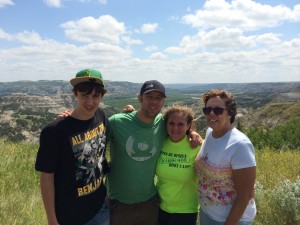
Jack, Dylan, Shelly, and Rene’: TRNP, ND.

North unit, TRNP.

Rock formation, TRNP.
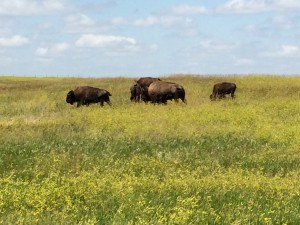
Bison, TRNP.
We only spent a few hours at Teddy Roosevelt but the vote, I am quite certain, was unanimous: Even though Fort Union was well done and impressive in its own right, the natural beauty and the wildlife of TRNP eclipsed all of our expectations. Did I recall being in the same places, seeing the same awe inspiring wonders when I was seven years old? Hardly. But that didn’t really matter. Being in the midst of such grandeur, such spectacular beauty, and experiencing it with my sons and family, well, that’s a new memory that outshines anything I could dredge up from the past. One thing I do remember from my trip here in ’62 is that we were warned, before descending to the valley of the Little Missouri, to be wary of rattlesnakes. Specifically, prairie rattlesnakes. I didn’t encounter any reptiles when I visited with my parents. But on this trip, I saw three varieties of reptile. First, I saw a sagebrush lizard sunning itself on the rocks. Then, thanks to the sharp eyes and ears of another visiting couple, I was able to see both a bull snake and a prairie rattlesnake hiding in the stones of an old CCC shelter at one of the park’s overlooks.
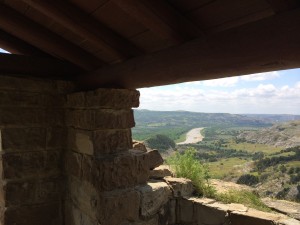
CCC shelter.
The couple had seen the tail of the bull snake extending from its cool hiding place. When they started walking away, the woman jumped back in fright. She heard the incessant rattle of a prairie rattlesnake also hidden in the rocks. The noise scaried the beejeebers out of her but she recovered nicely and moved on, none the worse for the surprise. The rattler and the bull snake stayed put and I was able to take a long, long look at them.
“Whatcha lookin’ at?” Rene’ asked from the inside of the pavilion.
“There’s a rattle snake and a bull snake down here in the rocks,” I answered.
Rene’, Jack, Dylan, and Shelly all joined me in hopes of seeing the snakes. The bull snake had enough and crawled deeper into its hiding spot. I pointed out the rattlesnake to Jack before starting back to the parking lot.
“Shit!”
I turned just in time to see Shelly leap and turn in the air. Dylan and Jack, who were standing a few feet away from Shelly, laughed at her antics. Apparently, the prairie rattlesnake decided it wanted to get a closer look at the tourists and, unbeknownst to Shelly, had crawled out of its lair. The rattler was sunning itself in broad daylight (but hidden by its camouflaged pattern) when Shelly nearly stepped on it.
“Good thing you heard the rattles,” I said from a safe distance. “He really doesn’t want to have to bite you.”
The dance Shelly did at TRNP will rival, I am sure, anything that goes on at the forthcoming wedding.
Monday morning, the Uhaul trailer returned to a scruffy lot in Williston, we packed the Pacifica and began the long drive home. As we rolled past man camps and new apartment buildings and travel trailers clustered like prairie schooners and oil rigs and new access roads and new wells and new drilling platforms, I recalled a piece I’d read in a brochure from Theodore Roosevelt National Park. The article noted that the park comprises 1% of the land forming the Bakken oil field, the vast underground reservoir of crude oil and natural gas extending beneath much of western ND, northeastern Montana, and southern Saskatchewan. The piece described Teddy Roosevelt’s campaign to preserve wild places and natural resources, juxtaposing TR’s conservation ethic against the explosive growth that is Williston’s present-day reality. The author of the article expressed concern for the fragile ecosystem of the Little Missouri given that fracking will likely take place on every plot of land surrounding this national treasure. What will our desire for American oil, oil produced to avoid foreign intrigue, mean to the valley that once housed Teddy’s ranch? I have no idea but, for the sake of our children and our grandchildren, to enable them to experience what my family experienced, I suggest we all keep diligent watch.

Jack and Dylan Munger, TRNP.
Peace.
Mark


